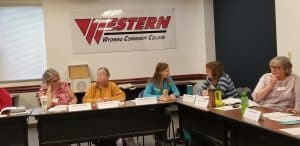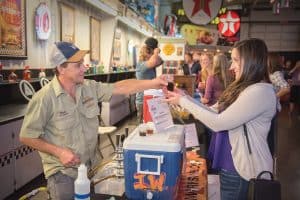
On February 19, United for Libraries (UFL) hosted “Friends and Trustees under 40: Recruit Them, Retain Them, Engage Them,” a webinar featuring tips for attracting millennials and younger adults to Friends groups, trustee boards, and foundations. The session was moderated by Jillian Wentworth, UFL’s manager of marketing and membership, and presented by members of UFL’s Millennial Engagement Task Force, which first began working on the subject of under-40 advocacy as part of an Emerging Leaders project in January 2018.
Presenters included Lina Bertinelli, workforce librarian at Enoch Pratt Free Library and the Maryland State Library Resource Center in Baltimore; Madeline Jarvis, adult and information services manager at Marion (Iowa) Public Library; Kathy Kosinski, member services and outreach manager at Califa Group, a consortium of California libraries; and Tess Wilson, community engagement coordinator for the National Network of Libraries of Medicine Middle Atlantic region. Visit UFL’s website for the full webinar and more.
The panelists are coauthors of All Ages Welcome: Recruiting and Retaining Younger Generations for Library Boards, Friends Groups, and Foundations (ALA Editions, 2020). The title is available for purchase at the ALA Store with a United for Libraries Action Planner PLUS+ Package that comes with the ebook plus hands-on activities and resources.
Why is it important that libraries develop their under-40 advocacy and recruit millennials to their boards, Friends groups, and foundations?

BERTINELLI: According to a 2017 Pew Research Center report, more millennials use the public library than any other adult generation. If millennials use the library so much, why are they so underrepresented in library advocacy groups? In the task force’s original research, we surveyed current and past members of library boards, Friends groups, and foundations, and more than half of the 866 respondents said there wasn’t a single millennial involved in their organization’s boards, Friends groups, or foundations.
It’s not intentional: 82% of respondents to our survey said that having a diverse membership was important to them, and not just so they could say that their organization is diverse. If millennials are core library users, we should want them to get involved behind the scenes and to fill us in on their perspectives and needs.
We also want to make sure we are retaining the younger folks we recruit, which led us to additional questions: How can we provide support to advocacy groups who want to increase millennial engagement? And how can we support millennials who want to get involved?
We had some ideas about why younger generations would want to serve on a board or in a Friends group. We thought, being new to the workforce, they might want to network or add something to their résumé. But ultimately, across generations, our survey respondents said they got involved with the library for altruistic reasons. They joined because they wanted to make a difference in their communities and because they love the library, or perhaps because their kids love the library.
What are some barriers to recruiting millennials?
BERTINELLI: One of the largest barriers to service that we found was inconvenient meeting times or inefficient meetings. Most of our survey respondents were baby boomers, and many of them joined their group or board after retirement. Someone who is early on in their career might not be able to take off work on a Monday afternoon.
Organizations should consider alternating when and where meetings are held, and asking themselves: Is everyone prepared going into the meeting so that we can focus on action items? Is everyone allowed to contribute, and is everyone being taken seriously?
Other barriers arise from differences in generations’ methods of operation, thinking, and
leadership. This doesn’t apply to every person, of course, but generally each generation approaches work slightly differently—from communication style to making decisions. If an organization can’t adapt or continues to follow outdated processes because it’s the way they’ve always been done, it might not be a space where new members will feel welcomed or most productive.
For a closer look at generational differences, we recommend the 2013 book Sticking Points: How to Get Four Generations Working Together in the 12 Places They Fall Apart by Haydn Shaw.
How do organizations outside the library world recruit and retain their volunteers? What can be learned from these approaches?

KOSINSKI: One of the things that kept coming up in our surveys and interviews was that library boards and Friends groups wanted active volunteers, they wanted active trustees, not someone who just shows up to the meeting. We figured this idea of active service would be a great way to tie volunteer firefighting to libraries. The US Fire Administration reports that up to 86% percent of fire squads are either entirely or mostly staffed by volunteers. A little more than half of these volunteer firefighters are under 40.
How can libraries attract young people committed to active service? They need to relearn their ABCs: accessibility, buy-in, and confidence, a framework described by Scott W. Blue in a 2016 article in Fire Engineering magazine about reviving volunteer programs.
Accessibility, as it pertains to recruiting and retaining volunteers, has two facets. First, is the group easy to join? And second, is its work easy to understand? Library groups need to invite people personally and should try community mailings, volunteer fairs, open houses, and local newspaper columns. Fire Engineering mentions junior firefighter clubs; maybe consider forming a junior trustee board or Friends group. If library organizations have enough content, they can start a Facebook page or website that includes an online membership application. Groups should essentially want everyone in the community to know who they are and to give the best first impression. For example, if a library group hasn’t updated anything online in six to eight months, it may look like it’s no longer active.
People need to understand that these groups exist and buy into their missions. Most people reading this know what a trustee board or Friends group is in relation to the library; not everyone in the community has that same knowledge. The most veteran members, and ideally community members who love the library, should be able to confidently describe to newcomers what the group does in easy-to-understand terms.
People like to know what they’re doing is making an impact on the world. They want to see themselves represented in organizational statements. They want activities that will allow for personal growth, whether that’s running a 5K or picking up marketing skills to help promote library events. People should know how their work connects to the library’s mission.
An acronym the volunteer firefighters use to describe an ideal volunteer is FIRE: fully informed and ready to engage. Volunteers need to feel empowered to take direct action, make decisions, and initiate change.
How can groups create welcoming, engaging spaces to encourage diverse leadership and meaningful representation across library organizations?

WILSON: To address equity, diversity, and inclusion within our boards, we need to understand how these principles consistently work toward a more equitable environment within our groups. The behavior and makeup of a board will likely trickle down and influence the library organization as a whole, so this work shouldn’t be siloed.
We took a lot of inspiration from resources beyond the library. One 2011 article in the Iowa Law Review suggests best practices for hiring and retaining diverse law faculty. The basis for this research shines a light on barriers that might affect library boards as well. Author Kellye Y. Testy states, “What’s most difficult about making progress in diversity is that the institution must work against the structural and systemic inequality that plagues every area of our society. As a result, the institution must apply even more sustained and aggressive pressure in order to overcome the significant and ubiquitous barriers to diversity and equality.”
The first step is to avoid tokenism. In our research, we heard testimonials from millennial board members who felt as though they had been recruited to help with social media, for example. Or let’s say there is one teen member on the board—how comfortable will that teen feel sharing their opinion in a room full of adult professionals? If a voice is present but not heard, what real progress is being made?
Another thing to consider is intersectionality. People are multidimensional and complicated. By boiling someone down to one quality—their age—we reduce them to a persona. This is unfair to that complex individual but also to the board, which is missing out on an enriching engagement with a whole person.
Broadly speaking, what are the effects of a more diverse and inclusive board? According to a 2013 study published in Equality, Diversity, and Inclusion, a board that values inclusive behaviors contributes to the “creation of a positive organizational culture of inclusion.” Another study found that nonprofits that embrace diversity and prioritize inclusion tend to be more active participants in advocacy. This suggests that an increasingly diverse board will be more deeply involved in the community it serves and will advocate for a more diverse body of users.
Isn’t that a great way to sum up our intentions? That eventually, our board will be engaged in the type of advocacy that attracts new, diverse members and that it will be doing that work so publicly and in such an immersive way that potential members will hear about it and be excited by it.
Where do Friends groups, trustee boards, and foundations go from here? How should they handle strategic recruitment and new-member onboarding?

JARVIS: Recruitment is an ongoing process, a year-round activity; libraries can’t just start when they need a body. Start right now.
There are two things library groups should do before they start looking at these relationships. First, groups should examine their strategic plan and goals. United for Libraries has a great guide to board self-evaluation, and state library associations are a great resource as well. Groups should think about which basic duties or functions they’re struggling with—fundraising, personnel issues—and let that drive their recruitment. Where are the challenges and, more importantly, where does the group thrive? How can the group capture that excitement to bring in new members?
And second, build that pipeline. Does the library have a teen advisory council? If not, Friends groups could work with library staffers to create one. Task forces are another easy avenue for community engagement, particularly for busy young professionals who might not have the time to serve on a board or older volunteers with passion projects.
As groups and boards advertise term length and limits, make sure that the terms are viable for all ages. For example, if a young professional doesn’t know how long they’re going to stay in one community, a six-year term length could be an automatic turn-off. Does a board term need to be that long? Could this work be done in three years? When boards cycle off, a greater variety of voices can be heard.
Think about that feedback cycle, and make sure there are opportunities for members to share ideas and to ask questions. Encourage new members to keep a log or a journal of their first 90 days and write down all the questions that they encounter during the onboarding process to help shape future orientations. Think about board mentorship or buddy programs. If a library group doesn’t know any young parents, why not reach out to the children’s librarian to make a plug at a storytime, asking for volunteers?
Ultimately, library groups should be flexible. They shouldn’t just accept how things have always been done. Rather, they should look at the talent within their communities, empower their members, and make sure they recruit folks who are excited and willing advocates—who have voices and are able to use them.


